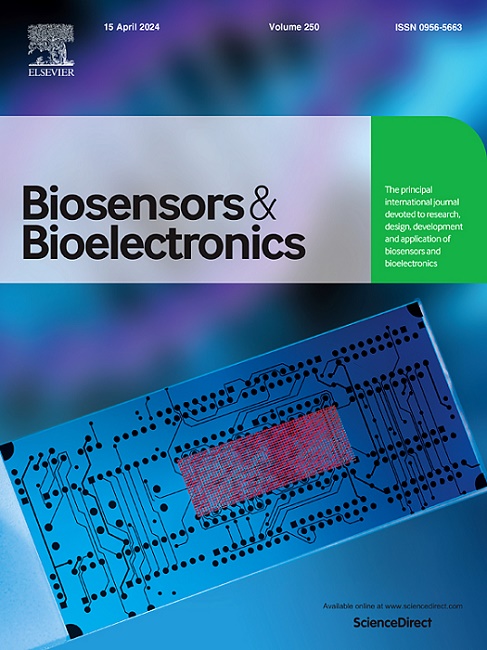Uniform 3D SERS substrate SiO2@AuAg collaborate with target-mediated DNA network structure as a signal amplifier for ultrasensitive detection of miRNA-21
IF 10.7
1区 生物学
Q1 BIOPHYSICS
引用次数: 0
Abstract
The uniformity of the SERS substrate significantly affects the signal reproducibility and sensitivity of the sensor. Therefore, optimizing uniformity of the substrate is crucial for enhancing the overall performance of SERS sensors. Herein, a uniform SERS substrate SiO2@AuAg, combined with a target-mediated DNA network structure as a signal amplifier, was developed to construct a three-dimensional (3D) SERS sensor for the ultrasensitive detection of miRNA-21. Specifically, the highly uniform 3D SERS substrate SiO2@AuAg is fabricated through liquid-liquid self-assembly. The orderly 3D structure provides a significantly larger specific surface area and an increased number of “hot spots”, thereby enhancing both the sensitivity and the repeatability of the proposed method. Additionally, DNA nanoflowers (DNFs) formed through self-assembly can incorporate a large number of methylene blue (MB) molecules, creating a stable 3D network structure on the SiO2@AuAg surface upon hybridization chain reaction induced by target miRNA-21. With the establishment of this 3D detection structure, the biosensor achieves ultrasensitive detection of miRNA-21 through a “signal-on” strategy, with a detection limit as low as 2.65 × 10−15 mol/L. Furthermore, this strategy offers a novel approach for designing advanced SERS biosensors for rapid and sensitive miRNA detection.
均匀的3D SERS底物SiO2@AuAg与靶标介导的DNA网络结构协同作为信号放大器,用于超灵敏检测miRNA-21
SERS衬底的均匀性显著影响传感器的信号再现性和灵敏度。因此,优化衬底的均匀性对于提高SERS传感器的整体性能至关重要。本文采用均匀SERS底物SiO2@AuAg,结合靶标介导的DNA网络结构作为信号放大器,构建了用于超灵敏检测miRNA-21的三维(3D) SERS传感器。具体而言,通过液-液自组装制备了高度均匀的3D SERS基板SiO2@AuAg。有序的三维结构提供了更大的比表面积和更多的“热点”,从而提高了所提出方法的灵敏度和可重复性。此外,通过自组装形成的DNA纳米花(DNFs)可以结合大量亚甲基蓝(MB)分子,通过靶miRNA-21诱导的杂交链式反应,在SiO2@AuAg表面形成稳定的三维网络结构。随着该三维检测结构的建立,该生物传感器通过“信号开启”策略实现了对miRNA-21的超灵敏检测,检测限低至2.65 × 10−15 mol/L。此外,该策略为设计先进的SERS生物传感器提供了一种新的方法,用于快速灵敏的miRNA检测。
本文章由计算机程序翻译,如有差异,请以英文原文为准。
求助全文
约1分钟内获得全文
求助全文
来源期刊

Biosensors and Bioelectronics
工程技术-电化学
CiteScore
20.80
自引率
7.10%
发文量
1006
审稿时长
29 days
期刊介绍:
Biosensors & Bioelectronics, along with its open access companion journal Biosensors & Bioelectronics: X, is the leading international publication in the field of biosensors and bioelectronics. It covers research, design, development, and application of biosensors, which are analytical devices incorporating biological materials with physicochemical transducers. These devices, including sensors, DNA chips, electronic noses, and lab-on-a-chip, produce digital signals proportional to specific analytes. Examples include immunosensors and enzyme-based biosensors, applied in various fields such as medicine, environmental monitoring, and food industry. The journal also focuses on molecular and supramolecular structures for enhancing device performance.
 求助内容:
求助内容: 应助结果提醒方式:
应助结果提醒方式:


